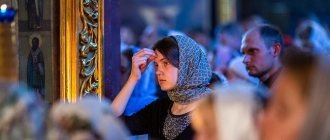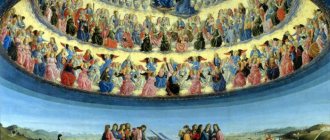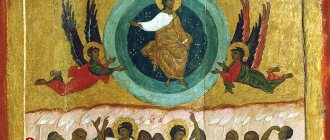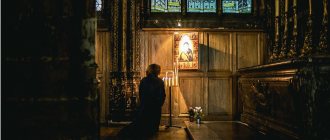If Christianity teaches good, then why are there so many evil people in the church? This question worries many who are just beginning to join religion. As a rule, a person first comes to church for consolation, for help before trials or during difficult periods of life. And then he meets unfriendly, often rude people. How should we treat them? With compassion, as well as for yourself. Accept this as a test sent to you by the Lord.
I wanted to light a candle, but received a lot of negativity
A young man came into the church to light a candle. I was just about to do this when I heard either a voice or a hiss behind me. He looked around and saw a man with a long beard and a blue robe, who whispered to him that he needed to immediately leave the women's quarters.
He went to another place, but stepped on some kind of rug, which was literally torn out from under his feet. I wanted to ask where he could put a candle, when he heard the same voice behind him, which made a remark to him that only atheists talk while reading the Gospel, he should be silent. The man with the beard said that before coming to the temple, you need to learn how to behave, and pointed him to the door.
At the institute where he studies, there are people who constantly go to church. I asked them what happened. I received the answer that you need to look at yourself first of all, rather than at others. The young man asks that being rude to others and looking at oneself is really Orthodoxy?
Planets with hidden oceans beneath their crust could be habitable
Photo of asteroid 2001 FO32, which flew safely past Earth
The craftswoman showed what beauty she makes from egg trays: there’s no shame in giving as a gift
Orthodox church and behavior in it
The temple consists of three parts: the altar, the temple itself, or quadrangle, and the vestibule (not all churches have it). The temple building is crowned with a dome with a cross. Next to the church there is a bell tower. Often it is adjacent directly to the temple, forming a single architectural whole with it.
1. Altar, 2. Chetverik, 3. Narthex, 4. Iconostasis, 5. Throne, 6. Altar, 7. High Place, 8. Sacristy, 9. Solea, 10. Ambon, 11. Choir
Altar
The altar symbolizes the Kingdom of Heaven. The word "altar" is of Latin origin and means "exalted altar." In the first centuries, Christians built altars on the tombs of martyrs and fenced off this part of the temple. Over time, this partition turned into an iconostasis. In our time, in the center of the altar, instead of a tomb, there is a holy throne, on which lies an antimension1 with particles of the relics of the holy martyrs sewn into it. The antimins is wrapped in a red board called iliton. In addition to the antimension, on the throne there is a Gospel, an altar cross, a tabernacle in the form of a small church, in which there are spare Holy Gifts for Communion to the sick at home, a monstrance in which the priest carries the Holy Gifts. Behind the throne is a seven-branched candlestick. Also behind the throne are an altar cross and an altar image of the Mother of God.
Monstrance
Behind the seven-branched candlestick, on a dais, there is a chair for the bishop, signifying the throne on which the Lord Almighty Himself invisibly sits. This is called a mountain place. On the left side of the altar there is an altar2.
The sanctity of the altar is so great that in ancient times all lay people were prohibited from entering it. Now this rule has changed somewhat, and men can enter the altar, but for this you need to have the blessing of the abbot. Women are prohibited from entering the altar. An exception is sometimes made for older nuns.
While in the temple, if possible, try not to turn your back to the throne. If you move from one part of the temple to another and cross the line of the altar, then you need to make the sign of the cross and bow towards the throne.
Temple, or quadrangle
Unlike the altar, which is dedicated to the Kingdom of Heaven, the middle part of the temple symbolizes the world of people, the created world. The worshipers are located here. In the ancient Church it was the custom for men to stand on the right and women on the left of the entrance. This rule is still preserved in many monasteries. In parish churches, there are no special rules for who or how to become a member. A person simply stands where he likes.
Iconostasis
“The iconostasis,” writes priest Pavel Florensky3, “is the border between the visible world and the invisible world.”
In its classical form, the iconostasis consists of five rows of icons topped with a cross.
The top row is the forefathers, in the person of the Old Testament forefathers it represents the Old Testament Church from Adam to Moses. In the center of this tier the Holy Trinity is depicted - the appearance to Abraham at the oak of Mamre.
Below is a prophetic series representing the Old Testament Church from Moses to Christ. It consists of images of prophets. In the center of the row is the image of the Mother of God “of the Sign” with the Child of God in her womb - the subject of the predictions and aspirations of the prophets.
The next tier is festive. Here are icons of the twelve main Orthodox holidays, the so-called “twelves.”
Below is a row of iconostasis, which is called deisis4. This is an image of the Mother of God, John the Baptist, archangels, apostles, saints, martyrs, who prayerfully turn to the central image of Christ the Savior. This row is the central and main part of the iconostasis. Its main theme is the prayer of the entire Church for peace and salvation.
The bottom row is local. It is called so because it contains a local (temple) icon, that is, an icon of the holiday or saint in whose honor the temple was built. In the middle of the local row are the Royal Doors. They usually depict icons of the evangelists and the Annunciation. On both sides of the Royal Doors there are icons of the Savior and, to the left of those praying, the Mother of God and the Child.
To the left and right of the Royal Doors are the northern and southern gates, respectively. It is customary to depict archangels or holy archdeacons on them, since deacons most often use them, and they are sometimes called “deacon’s” gates.
A small elevation in front of the iconostasis is called the solea; its middle part, protruding in a semicircle opposite the Royal Doors, is called the pulpit. To the right and left of the altar there are choirs - traditional places for the choir.
Narthex
This is the name of the part of the temple that precedes the quadrangle, or the temple itself. In many modern churches, church utensils, religious literature, crosses, candles, etc. are sold in the vestibule. Here you can submit notes about health and repose, order prayer services, memorial services, and receive prosphora5. This is a small piece of consecrated wheat leaven bread, baked in a special form without any additives other than salt. On the top of the prosphora there is imprinted a cross and the initial letters of the Savior’s name: “IC XC”, as well as the Greek word “NIKA”. All together it is translated: “Jesus Christ conquers.” There is a tradition: in the morning, on an empty stomach, eat a small piece of prosphora and drink a sip of Epiphany water. Believers take this water from church on the feast of Epiphany and store it at home throughout the year. Thus, pious Christians, having prayed and consumed consecrated food and drink, begin a new day.
Prosphora
Bell tower
Bells are one of the necessary accessories of an Orthodox church. They are placed on a special tower, which is called a bell tower, or belfry. Church bells are used to:
- call believers to worship. The ringing of one bell, sounding before the start of the service, is called blagovest;
– announce the performance of particularly important parts of the service. So, during the Liturgy, when the Sacrament of the Eucharist is celebrated, the bell is struck;
- the ringing indicates particularly solemn or mournful events of liturgical life, for example, the joyful Easter peal or the mournful funeral bell.
There is a pious custom: upon hearing the ringing of a bell, make the sign of the cross.
In church a person finds only what he is looking for
The young man apparently entered an Old Believer church. Old Believer traditions are very strict, this applies to both standards of life and behavior in church. As a rule, they greet strangers unfriendly. This can be understood, because in order to preserve their religion, their ancestors endured many hardships.
When going to a temple, you need to at least approximately know some of the traditions of behavior there. This applies to clothing and certain rules of behavior. And such “guys” are everywhere - in churches, synagogues, mosques and even in temples of culture. Here are just a few quotes from the priest, Archpriest Alexei Uminsky:
Whom did Christ drive out of the temple with a whip? Traders. But let's remember what Solomon's temple was like 2000 years ago? This was the only (!) place on earth where people prayed to the true God. There was no other sacred place - the ground was consecrated by the temple in Jerusalem. And from this greatest place Christ drove people out with a whip... Therefore, one should not be surprised that there are such people in a modern church. Although Christ persecutes them, they still return, because this is their place of bargaining... Why be surprised and blame Orthodoxy when this is a common thing - such people are everywhere.
An epidemiologist said whether re-vaccination with Sputnik V is possible
“This is if a man doesn’t have a wife”: children answer the question of what happiness is
Russian and American scientists want to “recode” mosquitoes by stopping them from biting
Archpriest Alexey Uminsky
People who visit the temple and believe in God say correctly that you should always pay attention to yourself. If a person in the temple makes a remark to you that is expressed to you in a rude manner, then try to forgive him.
Your friends who go to church tried to explain to you what happened: they suggested that you look not at others, but at yourself. Some person was rude - forgive him. Look at yourself: what are you good at? Maybe he really did something wrong... Yes, probably the reaction was too harsh - well, I got caught like this “guy.” Or maybe the Lord wanted you to finally check your Orthodoxy, what is it for you?
Archpriest Alexey Uminsky
Look at yourself from the outside. So a man comes to the church during a service and starts asking everyone questions. He doesn’t care that the service is going on, people are praying at this time, talking to the Lord, listening to the reading of the Gospel. He has a question: “Where can I put a candle?” Why not ask the same “aunts in headscarves” or “guys with a beard” at the entrance, or just open the Internet. Think about yourself, because in order to fulfill your desire - to light a candle to get a good grade - you disrupt the usual rhythm of the service and distract many people.
Scientists have developed edible cling film based on seaweed
A simple way to grow a new flower from the stump of a wilted orchid
A cold turned out to be able to partially suppress the coronavirus: scientists’ conclusions
If we go to church not to see God, but in order to receive something from Him, then we receive “something”. And as a priest, I can say that in such cases people, fortunately, receive not at all what they “ordered,” but what the Lord wants to give them. And sometimes He gives us a “brain punch”: a person goes to light a candle, and the Lord wants to tell him something important. And He speaks, but he does not hear. This means that you need to somehow revive, shake the person: “Yes, listen, finally!” And then the “guy with the beard” comes and starts making comments.
Archpriest Alexey Uminsky
There is no need to be offended by the “man with a beard,” but look at yourself. After all, you are like a “bull in a china shop.” You go to the women’s quarters, step on a rug that is needed for some ritual, ask questions while reading the Gospel and consider yourself offended?! How many people have you offended with your rash behavior?
Maria, 27 years old
Candlestick of the house church of the holy martyr Tatiana at Moscow State University. M. V. Lomonosova
Photo by Vladimir Eshtokin
I won’t say that there was no faith in my life before, and then one day it appeared. I was baptized in infancy, after which my grandmother took me to church several times a year. I started going there independently and consciously at the age of fifteen - at first it was sporadically, then more and more regularly, and after the entrance exams to the university I became a permanent parishioner in our church.
Several years passed like this, then I suddenly found myself without a job. While I was thinking about where to go and what prospects there were, I was invited to work in a candle shop. What was needed was a person not from outside, but from the parish.
You don’t just sit here and sell something - this is not the job of a seller as such . This is immediately the work of a psychologist, consultant, and even a catechist . People come and ask all kinds of questions, sometimes very strange, wild or very banal questions. For example: “Do you have an icon for everything?”, “And for wealth?”, “How can I order a prayer service so that my loan will be approved?”
And you are obliged to answer to the best of your education, adequacy and knowledge of church life. When the question is very complex or a person just needs to talk to him, it is better to send him to a priest if you do not know a definite answer. And this is not so much the area of catechesis as of psychology. People come and talk about their whole lives, about their troubles, about how something didn’t work out for them or about family problems.
You need to be patient with people and their weaknesses . You can’t sit there looking like you know everything better than anyone here, but complete ignoramuses come to you, you can’t treat them condescendingly. We must try to always be welcoming and friendly.
I won’t say that a candle box worker must have super-deep theological knowledge, but he must know the basis of the doctrine firmly. So that he himself does not give rise to even small superstitions in people. Because you have no right to talk nonsense . Naturally, you need to know the Catechism very well in order to answer the simplest questions.
Photo by Vladimir Eshtokin
The most difficult thing is interaction with inadequate or simply sick people . Sometimes you just don’t know how to behave. You feel that a person can suddenly become aggressive. When such people come, it is quite a strong nervous tension.
The very opportunity to talk about Christianity inspires me . You helped a person understand something, part with a small delusion that was poisoning his life. I am very happy when people buy crosses for christenings. It's always very nice.
It’s great when you have something that a person has been looking for for a long time and could not find in other places, but we have it. Most often this is a rare icon of a saint or a personal icon.
I think it's somewhere between work and service . You see, to call this service with a capital M means to unjustifiably elevate oneself. The priest’s service is indeed many times more difficult for him than for any other person working in the church.
I can say with confidence that this definitely cannot be called a profession. Of course, this is work, in the most ordinary, literal sense of the word - you come at a certain time and fulfill obligations to sell goods and services, but also service, of course. If a person consciously does this all his life and this is his main occupation, then perhaps one can say so. But this is very rare. Basically, people combine work in a church shop with other activities.
I do not set myself any great task of Orthodox education, because thousands of people are already working on this. But there are some little things and conventions in which I consider it my duty to help understand and explain that God is not in candles and not in notes. We need to slowly move away from this “magical” attitude towards simple ritual moments.
A man of about forty, who looks Japanese, periodically comes to see us. Each time he gives me money and a very neatly printed piece of paper in a file, on which is written the magpie “for the repose” with photographs of several Japanese people and their Orthodox names. Apparently, he was asked, and he regularly comes to do this.
The rest of the time I like to travel around the world and the country, I am seriously interested in cinema and read a lot. I regularly write about all this on my blog for myself and my friends who are interested in my texts.
Is it possible to believe in God and not fulfill his commandments, and even be a cosmic energist?
In her letter, the girl says that they have an elderly woman at work who regularly attends church, knows all church holidays, quotes the Gospel and at the same time does unpleasant things: lies, discusses others, makes reservations when it is beneficial to her, and can even curse people. At the same time, she claims that she is a cosmic energizer, has a connection with the Cosmos, and he fulfills all her desires. Why do such people go to church?
Bringing the rose bush back to life after winter: how to properly reanimate flowers
St. Petersburg and other regions with the largest increase in crime in 2020
“There is only emptiness around...”: how to understand that your soul is tired (and not your body)
Roman, 48 years old
Candlestick of the Church of St. Seraphim of Sarov on Krasnopresnenskaya embankment
Photo by Vladimir Eshtokin
I became a candle maker very simply: they offered me, but I didn’t refuse. At that time, I completed my military service, received three higher educations in economics, and successfully worked as the manager of a foreign car dealership. He also taught several original courses at the Faculty of Economics of Moscow State University.
My parents baptized me in infancy, and from then on the temple became a part of my life. Adults took me there, and they taught me a respectful attitude towards the Church and faith. He began to come to services on his own already at a conscious age - at first he simply stopped by on the way, then this began to happen more and more often.
When I regularly went to church as an ordinary parishioner, I never thought of working there. One day, our candle maker urgently needed to leave his position, and the priests were looking for a replacement to take his place. I didn’t need money from them, and they didn’t have a budget for this function, so we quickly found a common language, and I started working on my only day off. This is very similar to the movie character Forrest Gump, who worked as a gardener and had a decent fortune.
The position of a candle maker is not a job for me and certainly not a profession. It is rather a service that consists of helping the people serving in the temple and those who came to it . In general, this can be compared to the activities of a sailor on the upper deck of a small ocean schooner: helping passengers, other sailors and the captain. And at other times, scrub the deck.
Photo by Vladimir Eshtokin
To work as a candle maker, all you need is a little life experience , humility and a sense of humor. You also need to be able to sort notes, sweep the floor, and feel free to take out the trash.
There is an opinion among people that only people who have failed in life and have nothing else to do work behind the candle box. Therefore, you need to be prepared for a condescending attitude and try to react kindly.
One day, an elderly Mexican couple came here - husband and wife. They were very interested in the history of the temple and asked many questions about faith. We said goodbye to them, and then they came three hours later and gave me a small laminated icon of the Mother of God - in their homeland this is a revered Christian image. It turned out that this is the icon of the Mother of God “Increasing the Mind”, only they have it in green tones, and we have it in red.
In my free time I grow oaks, apple trees, and walnut trees. It captivated me so much that I had to leave Moscow for the village. You understand that the trees on the loggia do not grow as expected. I also respect amateur ballroom dancing and paint coffee and tea cups. The latter takes a lot of time and effort, but museums and private galleries are already asking for my works to be exhibited.
Rights of clerics
Among elders and deacons, primacy is determined by the rank or seniority of consecration, or consecration.
According to the instructions of church canons and customs , lower clergy are obliged to show due respect to higher ones, but excessive signs that are contrary to the spirit of Christianity are not welcome. In the Russian Empire, clergy received great advantages in society. According to the Table of Ranks, bishops were equal to the highest civil and military ranks. All noble privileges extended to clergy and their children.
Nowadays, clergy do not have privileges over other members of society and can enjoy all the rights and freedoms available to any citizen. Clergymen have the right to receive honorary titles and state awards.
Bishop
Servant bishops have the right to perform the full sacrament of sacred rites. Catholics trace their history back to the time of the apostles. The apostles were given spiritual gifts by the Holy Spirit on the day of Pentecost. The bishop must be over 35 years of age and ordained more than five years before. The bishop must also have a doctorate in theology. He must be well versed in canon law and the scriptures. Typically, bishops govern dioceses in their region.
Becoming a bishop is a very important moment in the life of most Catholic clergy. All higher ranks have the title of bishop. Bishops retire at age 75. To do this, you need to submit your resignation to the Pope. The Pope then begins work on this petition, he must find a suitable replacement. The office of bishop is the third and most complete level of the Sacrament of Holy Orders.
Dad
Pope is the highest rank a member of the clergy can receive. He is the leader of the Catholic Church. The Pope is elected by cardinals who are under 80 years of age. this is done when the previous Pope died. The Pope's term of service has no limit, being lifelong. The office of the Pope is called the papacy.
The Pope rules the Catholic Church as a monarch of the state, and is the head of state of the Vatican City. The Roman Curia helps the Pope cope with his duties. The Curia emerged from a local assembly of elders, deacons and notaries performing secretarial duties. The first bishops of Rome relied on them. But from the 11th century, only cardinals began to participate in the Curia. The offices of the curia are responsible for the financial welfare of the papacy.
Once elected, the new Pope is given a royal name. Often this is the name of one of the previous Popes, which is given to the newly elected as a sign of respect for the departed. Each Pope can choose the name of a Saint with whom he feels a special connection. Catholics firmly believe that their Pope is infallible. They believe that God will not allow him to be misled and will not allow him to do anything wrong.
Thus, the Catholic clergy is a rather complex community. It consists only of men, since the Catholic Church does not accept women into the clergy, but that is another story.
Who is a cleric in Christianity
The term cleric in its broadest sense is usually understood to mean the clergy as a whole. All clergy devote themselves to serving the Church and obey the laws in force within it.
In a narrower sense, clergymen who directly perform divine services in churches are usually called clerics. This category includes readers, deacons, sextons, bell ringers, priests and singers. The exception to this group is the bishops and some other ministers of the Church.
In the earliest years of the formation of the Christian Church, the apostles were considered the most authoritative persons. It was then that the church hierarchy began to form, which still exists today. Ordination is required to enter the clergy. This is the name of a special sacrament that allows you to join the community of clergy.
Currently, only males who have been baptized can join the clergy. However, there are several known cases where women were ordained. However, they were forbidden to perform services inside the temple. In addition, there are age restrictions. The minimum age for deacons is 25 years. The age for receiving the rank of subdeacon is 20 years, and that of presbyter is 30 years. Children from three years old can be accepted as readers and singers.










